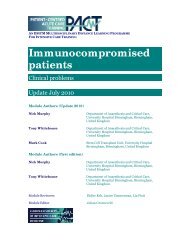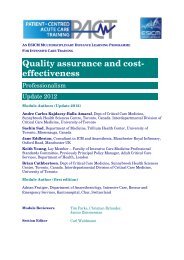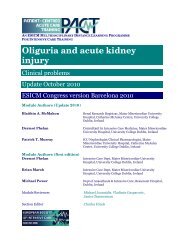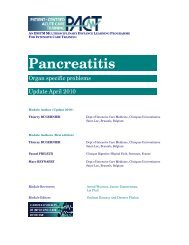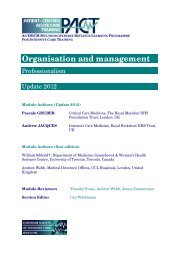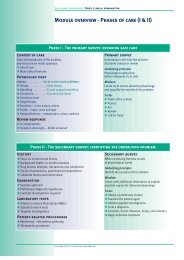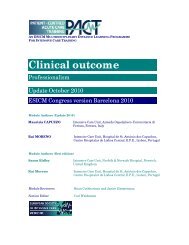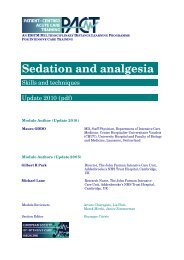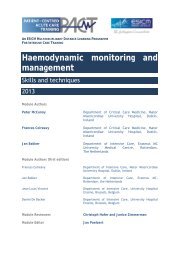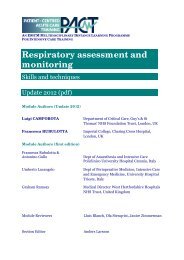Burns injury - PACT - ESICM
Burns injury - PACT - ESICM
Burns injury - PACT - ESICM
Create successful ePaper yourself
Turn your PDF publications into a flip-book with our unique Google optimized e-Paper software.
Singer AJ, Taira BR, Thode HC Jr, McCormack JE, Shapiro M, Aydin A, et al. The<br />
association between hypothermia, prehospital cooling, and mortality in<br />
burn victims. Acad Emerg Med 2010; 17(4): 456–459. PMID 20370787<br />
Airway management on scene<br />
If the patient has a facial burn or if there was a fire in a closed room, direct<br />
inspection of the oropharynx should be performed, preferably by a physician<br />
experienced in airway management. This procedure might be difficult to achieve in<br />
the pre-hospital setting. Carbonaceous sputum, hypoxia and hoarseness indicate<br />
inhalation <strong>injury</strong> (see the section on inhalation <strong>injury</strong> in Task 4, below) and most<br />
experts will advocate tracheal intubation in this setting. If there is doubt about the<br />
patency of the airway, intubation should be performed with a cuffed (endo)tracheal<br />
tube (ETT) that has not been cut. Due to oedema formation, a smaller ETT may be<br />
required. A selection of ETT sizes and intubation aids should be available, including<br />
‘difficult airway trolley’ if a difficult intubation is expected (usually not available on<br />
scene). Secure the tube properly after intubation. The indication to intubate should<br />
be broad; it is easier to extubate a patient when significant airway <strong>injury</strong> has been<br />
excluded than to intubate a patient with extensive airway burns which are identified<br />
later. Note that signs and symptoms of airway oedema may only become apparent<br />
when intravenous resuscitation is established - potentially during inter-hospital<br />
transport.<br />
See the <strong>PACT</strong> module on Airway management.<br />
All (endo)tracheal tubes should be well secured, especially in patients with<br />
facial and neck burns. The tracheal tube may be very difficult or impossible to<br />
reinsert if accidentally dislodged.<br />
Many use un-cut tracheal tubes to pre-emptively correct for anticipated<br />
oedema. If the tube is to be cut, do not cut the ETT to a standard ‘oral length’ as<br />
patients with facial and inhalational burns commonly develop marked oedema and a<br />
cut tube may ultimately become too short and be difficult to secure and/or become<br />
dislodged. [Images in interactive version]<br />
Eastman AL, Arnoldo BA, Hunt JL, Purdue GF. Pre-burn center management of<br />
the burned airway: do we know enough? J Burn Care Res 2010; 31(5):<br />
701–705. PMID 20634705<br />
4




